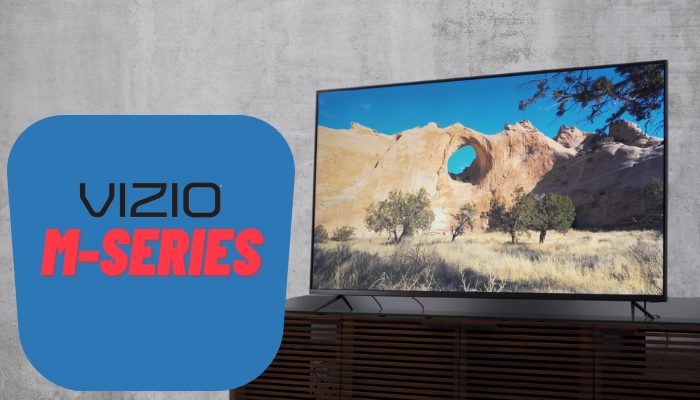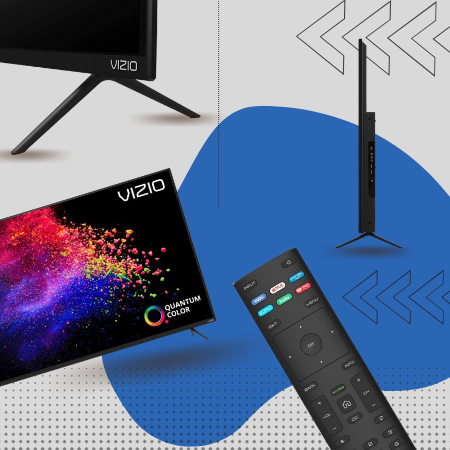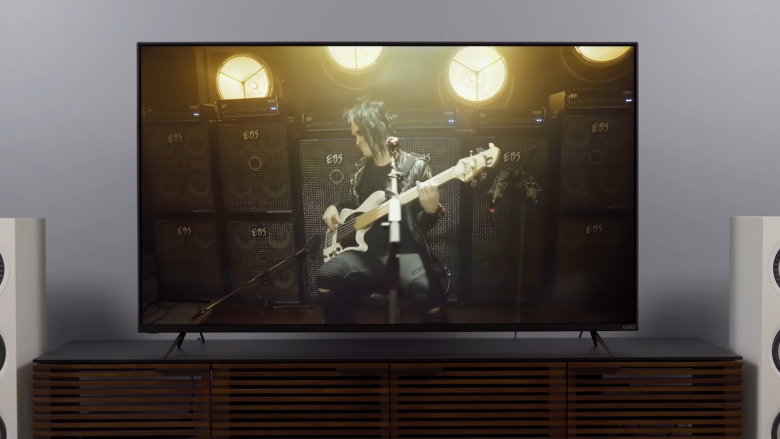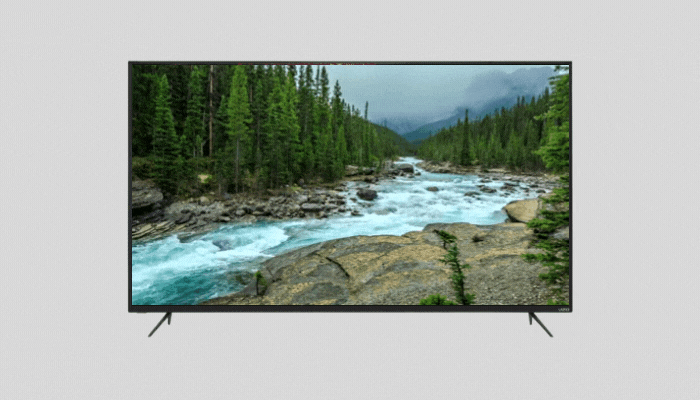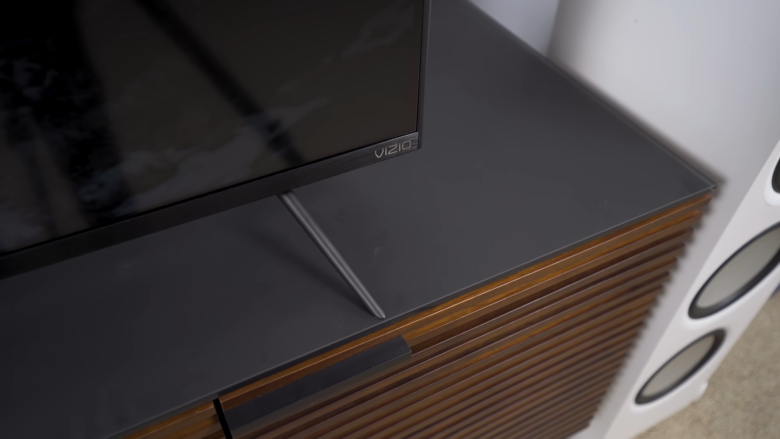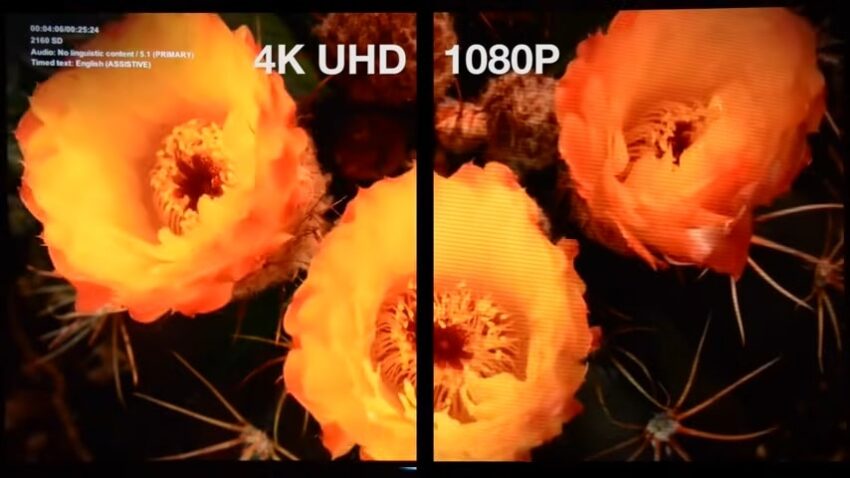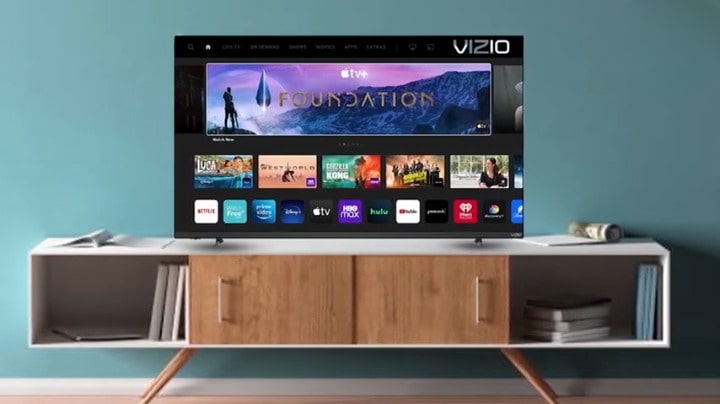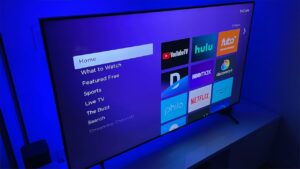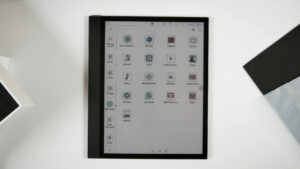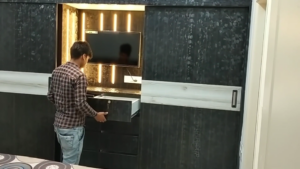The Quantum Vizio M-Series provides the best smart television you’ll get for less than $1,000. Together with Dolby Vision assistance, it has remarkable picture quality and excellent HDR performance with local dimming and color-boosting quantum dot technology.
A built-in Chromecast brings up a wide variety of applications and facilities, and the new SmartCast software contains Apple AirPlay2 and HomeKit help, rendering it just as useful for iOS users.
Vizio M-Series 4k Smart TV
Design
The Vizio M-Series Quantum’s general design is mainly unchanged from the past year, but this is certainly an instance where nothing especially required to change. The top and sides of the screen are surrounded by slim black bezels, with a wider bezel running along the bottom. A silver Vizio logo, the only important aspect on the front of the set, is in the bottom right corner of this.
Without the stand, the TV covers 57.3 x 35.6 x 2.8 inches. Due to a patterned texture that covers the back of the cabinet, the back of the TV isn’t as flat as you’ll see on most TVs. The design of the TV is reasonably sturdy, made of black plastic, and weighs 53.4 pounds.
Specifications
| Price: $999 |
| Screen Size: 65 inches |
| Resolution: 3840*2160 |
| HDR: Dolby Vision, HDR10, HLG |
| Refresh Rate: 60 Hz |
| Ports: 4 HDMI, 1 USB |
| Audio: 2*20-watt |
| Smart Tv Software: Smartcast OS 3 |
| Size: 57.3*35.6*2.8 inches |
| Weight: 53.4 Pounds |
Picture Quality
Aside from the viewing angle and poor input upscaling the Vizio M Series has a good picture quality. Its contrast ratio maintains a higher than average score for deeply colored blacks. The M Series also has a good color gamut, and though it is not truly “wide” the remaining colors onscreen are saturated nicely as well.
The brightness is a nice side note for the M Series. Glare is fought off as well as reflections in most cases.
Performance
The M-Series Quantum offers some really outstanding performance for a collection that buys for less than $1,000 with a combination of quantum dots to increase brightness and color and a complete range of local dimming for deeper blacks and brighter brights.
Watching a movie filled with vivid colors and quick action, like Spider-Man: Homecoming, I was happy to see that the M658-G1 designs appeared real to reality. The Washington Monument’s daytime shots were packed with red, white and blue flags, beautiful green landscaping and lots of moving people, and it all appeared smooth and vivid.
High dynamic (HDR) content also feels good on the M658-G1 with the help of both HDR10 and Dolby Vision.
A Spider-Man night battle scene with a monster on a dull lake was dull enough but punctuated with vivid fire and glowing lights. And unlike the results we saw on the P-Series Quantum PQ65-F1 last year (Vizio’s first quantum-dot display), the person backlighting areas did not trigger the kind of separate flaring that was so common on that collection.
Contrast Ratio
Contrast Ratio: ~4600:1
Bottom Line: Above Average
as many others will point out, the 2018 version of the Vizio M Series technically has a worse contrast ratio, but in reality, it is still good. This is because the overall performance is the key standard here which the M Series does well.
Local Dimming
Local Dimming: Yes
Backlight: Full-Array (FALD)
Bottom Line: Below Average
As with many other smart TVs from 2018, the M Series has poor local dimming features. The “Xtreme Black Engine Plus” in no way actually enhances the contrast ratio and instead leads to blooming/clouding around the affected areas. I recommend that you leave this particular setting off or medium at most on the Vizio M Series.
Viewing Angle
Viewing Angle:~23°
Bottom Line: Narrow, but Expected
Both the M55-F0 and M65-F0 have VA (vertically aligned) panels. These panels are known to have better contrast ratios while sacrificing their viewing angles. So in the case of the Vizio M Series, you’re best off expecting this result so as to not be let down. Though the picture holds up for a little bit when sitting to the side, I estimate anything more than ~23° is just a different picture at that point.
Input Upscaling
480p: Blocky, but as expected with most methods of upscaling work in a way that produces ‘blocky’ results.
720p: Scenes are softer than desired, but this is true for many of the best 2018 TVs right now.
1080p: Refined details that are quite sharp while retaining the quality.
4K: Great quality.
Bottom Line: Textbook
Content of all levels looks quite good on the M Series TV, but 480p will take some getting used to as it is a bit blockier than most would like.
Color Gamut
DCI P3 Color Space
DCI P3 xy: ~75%
DCI P3 uv: ~80%
Rec 2024 Color Space
Rec 2024 xy: ~55%
Rec 2024 uv: ~60%
Wide Color Gamut: No
Bottom Line: Good
Even though the M Series does not “truly” have a wide color gamut, that’s not to say the picture quality is not good. With my Vizio M Series TV review, I found the supported colors to be properly saturated in contrast to the deep blacks or bright whites in the picture. Though, with the newer smart TVs being released as the year goes on, it would have been nice to have some extra oomf from the M series.
Motion Handling
A fast response time is the biggest thing the Vizio M Series 2018 has going for it under its motion handling. The trail is quite little and the eye tracking is nicely reduced, but the 24p playback is not well supported while the 60 Hz refresh rate doesn’t allow for motion interpolation if any at all.
Motion Blur
Response Time:~13 ms
Bottom Line: Great
In addition to helping fast-moving content look to smother the response time of the M Series combines well with the low input lag it also has to make it a solid choice as one of the best TV for video games. You can notice the effect of the response most largely with sports or movies.
24p Playback
24p: Yes
24p via 60p: No
24p via 60i: No
Bottom Line: Poor
The M55-F0 and M65-F0 both struggle to remove judder from most sources. The one saving grace is that the built-in applications help to remove judder. For instance, on the Vizio M Series, if you are using the Netflix application, you are likely judder free as it is an application on the smart TV itself. Judder can be a bit of a hit-or-miss type of thing with most people so please let me know if you find anything different.
Motion Interpolation
30 FPS: No
60 FPS: No
Soap Opera Effect: No
Bottom Line: Poor
There are no settings to smooth the picture of the M Series further. This is a bit of an odd feature for a smart TV to not have, but in my opinion, it is not needed either.
Inputs
After finishing my Vizio M Series TV review, I noticed the inputs had improved the most compared to other metrics. The input lag has lowered dramatically for gaming, the M Series now has a TV Tuner, and it now has more support of the common PC resolutions that the previous models did not have. These are very good adjustments that Vizio has made for the M Series.
All Inputs:
USB: 1
Digital Optical Audio Out: 1
Analog Audio Out RCA: 1
Component In: 1 (shared)
Composite In: 1 (shared)
Tuner (Cable/Ant): 1
Ethernet : 1
For everyone that nearly threw their previous M Series out of the window, please note there is now a TV Tuner.
1080p @ 60Hz @ 4:4:4: Yes
1080p @ 120Hz: No
4k @ 30Hz @ 4:4:4: Yes
4k @ 60Hz: Yes
4k @ 60Hz @ 4:4:4: Yes
Bottom Line: Great
All of the commons resolutions are supported by the M Series aside from 1080p @ 120 Hz. This is because the M Series only has a refresh rate of 60 Hz.
VESA Pattern
What is a VESA pattern?
M55-F0: 200 x 200 mm
M65-F0: 400 x 200 mm
Input Lag
Best Input Lag: ~20 ms
Bottom Line: Great
With an input lag as low as this, the Vizio M Series is potentially making a case for the best TV for video games. All kinds of games just work better when you can properly react to the incoming information and with the well-budgeted price of the M Series, can you go wrong? One thing to note is that the ‘Game Low Latency’ settings will need to be enabled to lower the input lag. Aside from that, you’re off to the races.
Input Features
HDR10: Yes
Dolby Vision: Yes
5.1 ARC Dolby Digital: Yes
5.1 Passthrough ARC DTS: Yes
5.1 Optical Dolby Digital: Yes
5.1 Optical DTS: Yes
ARC: Yes (HDMI 1)
Even though the Vizio M Series 2018 does not have a ‘wide’ color gamut, HDR10 is still supported.
Smart Features:
The Vizio M Series 2018 runs the Google SmartCast operating system. In terms of overall functionality, it is quite good. The applications that the M Series has worked well and they are always easy to find, but that is about most of it. You cannot download more apps or add extra functions you might find useful.
Operating System
google-smart-cast-vizio-trt
Operating System: SmartCast Powered by Google
Bottom Line: Smooth, but Basic
The main attraction of the SmartCast platform is that you can stream content (photos, music, or videos) from just about any type of device you want to. I found this particularly useful when having friends over. Sharing videos through YouTube, queuing up songs through Spotify or exchanging photos from our phones is a breeze.
The M Series variants (M55-F0 and M65-F0) do not come with advertisements built into their smart features. Personally, this is a huge plus. Immersion is a key element when using a smart TV and the ads take away from that experience. You will find some suggested content based on prior TV usage, but that is about the extent of what the M Series will bother you with.
- Excellent picture quality with vibrant colors, deep blacks, and good contrast
- Full array local dimming backlight enhances picture quality and reduces blooming
- Smart TV functionality allows for easy streaming of content from popular apps like Netflix, Hulu, and Amazon Prime Video
- Supports HDR content, making colors and contrast even more stunning
- Comes at an affordable price compared to other brands with similar features
- Viewing angles are limited, so picture quality may degrade when viewed from an angle
- Built-in speakers aren’t very powerful, so investing in a soundbar for a better audio experience may be necessary
- Smart TV interface can be slow at times, and the remote may be unresponsive
- Doesn’t support Dolby Vision HDR, which some may see as a drawback
FAQ
What is the difference between 4K and 1080p?
4K refers to a resolution of 3840 x 2160 pixels, while 1080p refers to a resolution of 1920 x 1080 pixels. 4K offers a higher resolution and more detail than 1080p but also requires more bandwidth and processing power. This means that you will need a fast internet connection and a powerful device to stream 4K content.
What is HDR?
HDR stands for High Dynamic Range, which refers to a range of colors and brightness levels that are greater than those found in standard content. HDR content offers more detail in both bright and dark areas, resulting in a more vibrant and realistic image.
What is a refresh rate?
The refresh rate refers to how many times per second the image on the screen is updated. The higher the refresh rate, the smoother the image will appear. Most TVs have a refresh rate of 60Hz, but some newer models offer 120Hz or even 240Hz.
What is a viewing angle?
The viewing angle refers to how far off to the side you can be while clearly seeing the image on the screen. TVs with narrow viewing angles may appear washed out or distorted when viewed from the side, while TVs with wider viewing angles will maintain their image quality even when viewed from an angle.
What is input lag?
Input lag refers to the delay between when you press a button on your controller or keyboard and when the action appears on the screen. TVs with high input lag can make it difficult to play fast-paced games or react quickly to on-screen events.
What is Dolby Vision?
Dolby Vision is a type of HDR that offers even greater color accuracy and contrast than standard HDR. It is used in some high-end TVs and streaming services and requires specialized hardware and software to display properly.
Can I use voice commands with the Vizio M-Series 4k Smart TV?
Yes, the Vizio M-Series 4k Smart TV has built-in support for voice commands through Amazon Alexa and Google Assistant.
What apps are available on the Vizio M-Series 4k Smart TV?
The Vizio M-Series 4k Smart TV comes with a variety of apps pre-installed, including Netflix, Hulu, Amazon Prime Video, YouTube, and more. Additionally, you can download and install additional apps from the Vizio SmartCast app store.
Can I connect my gaming console to the Vizio M-Series 4k Smart TV?
Yes, the Vizio M-Series 4k Smart TV has multiple HDMI ports that allow you to connect your gaming console, Blu-ray player, or other devices.
Does the Vizio M-Series 4k Smart TV come with a warranty?
Yes, the Vizio M-Series 4k Smart TV comes with a one-year warranty that covers any defects in materials or workmanship.
How do I update the software on my Vizio M-Series 4k Smart TV?
You can update the software on your Vizio M-Series 4k Smart TV by going to the “System” menu in the settings and selecting “Check for Updates.” If an update is available, you can download and install it from there.
Conclusion
Over the past couple of years, Vizio has produced significant progress, and the quantum-dot push of this year has maintained that momentum by providing an outstanding show with great value.
The M-Series Quantum provides excellent brightness and HDR efficiency, strong color and image quality, and better-than-average sound for a collection that is probably the middle kid in Vizio’s lineup. The Vizio M-Series Quantum 65-inch (M658-G1) provides you with a lot to know for its under-$1,000 cost with a changing smart-TV system and plenty of interfaces and features.
Take a look at these products from the same price range, that are available right now on Amazon:
Related Posts:
- Sony Z9F 2024 Review (XBR65Z9F) - Best 4k TV for…
- From Romantic Movies to Action: An Overview of…
- 10 Best Wireless Headphones for Your TV in 2024 -…
- Vizio E Series HDR Smart TV 2024 - Step into a New…
- Vizio P Series TV 2024 Review - 4k Picture Quality…
- 11 Best 4K Smart TVs For Movies 2024 - Top Picks for…


